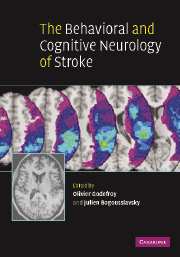Book contents
- Frontmatter
- Contents
- Contributors
- Preface
- 1 Evaluation of cognitive and behavioral disorders in the stroke unit
- Motor and gestural disorders
- Aphasia and arthric disorders
- Hemineglect, Anton–Babinski and right hemisphere syndromes
- Agnosia and Bálint's syndrome
- Executive and memory disorders
- Behavioral and mood disorders
- 22 Akinetic mutism and related disorders
- 23 Alterations of level of consciousness related to stroke
- 24 Delirium and confusional state in stroke patients
- 25 Post-stroke delusion
- 26 Acute behavioral and mood changes
- 27 Stroke and personality change
- 28 Post-stroke mania
- 29 Depression after stroke
- 30 Fatigue
- Dementia and anatomical left/right syndromes
- Index
- References
24 - Delirium and confusional state in stroke patients
Published online by Cambridge University Press: 10 October 2009
- Frontmatter
- Contents
- Contributors
- Preface
- 1 Evaluation of cognitive and behavioral disorders in the stroke unit
- Motor and gestural disorders
- Aphasia and arthric disorders
- Hemineglect, Anton–Babinski and right hemisphere syndromes
- Agnosia and Bálint's syndrome
- Executive and memory disorders
- Behavioral and mood disorders
- 22 Akinetic mutism and related disorders
- 23 Alterations of level of consciousness related to stroke
- 24 Delirium and confusional state in stroke patients
- 25 Post-stroke delusion
- 26 Acute behavioral and mood changes
- 27 Stroke and personality change
- 28 Post-stroke mania
- 29 Depression after stroke
- 30 Fatigue
- Dementia and anatomical left/right syndromes
- Index
- References
Summary
Main characteristics of delirium and confusional state
Delirium or acute confusional state (ACS) is a mental disorder characterized by acute onset, altered level of consciousness, fluctuating course, and disturbances in orientation, memory, thought, and behavior (Lipowski, 1990). This condition is frequent in stroke patients, although stroke is a rare cause of ACS. Many predisposing factors have been identified. Stroke per se may, however, induce ACS. The occurrence of this behavioral disturbance adversely influences outcome in stroke patients. However, no specific treatment is available.
ACS is an acute, transient disorder of consciousness and cognition with fluctuating intensity. The symptoms of delirium are wide ranging, and although they are non-specific, their abrupt or rapid onset and their fluctuating nature is highly characteristic and is a valuable diagnostic tool. The main feature of delirium is disordered attention with difficulties in focusing and sustaining attention on one stimulus and difficulties in shifting attention to new external stimuli: attention wanders, perseverations may be observed. Attention disturbances are not isolated and examination will reveal abnormalities of thinking, perception, and memory. The change in cognition includes impaired memory, language (anomia, incoherent speech, aphasia, agraphia), disorientation to time and place and visuospatial dysfunction. Perception disturbances may also be present with illusions, hallucinations, or delusions. Sleep–wake abnormalities are frequent with daytime sleepiness and reduced and fragmented sleep during the night with nocturnal agitation, shouting, and aggressivity. Many individuals are restless and hyperactive while others are lethargic.
- Type
- Chapter
- Information
- The Behavioral and Cognitive Neurology of Stroke , pp. 489 - 509Publisher: Cambridge University PressPrint publication year: 2007



